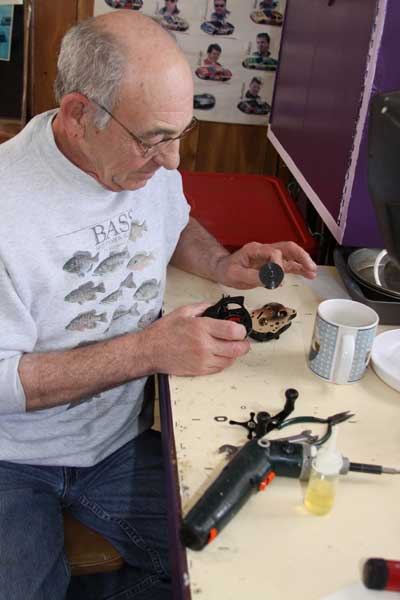 Moe RanieriHas this ever happened to you?
Moe RanieriHas this ever happened to you?
It’s mid-summer, you’re on the lake, the fish are bitin’ and your favorite reel begins to act up.
Maybe it growls, develops a strange vibration with every turn of the handle, or the spool won’t engage.
Moe Ranieri has turned a hobby of fixing reels into part-time job.
Something like that happens to me every year. Not that I don’t have good reels; I just don’t take very good care of them.
That’s why I dropped some off at Moe Ranieri’s place the other day. In addition to working part-time in the reel department at Lunker’s, he has a tackle repair service in his Cassopolis, Mich. home.
Embarrassingly, none of my reels had ever been cleaned, yet when Moe got done with them, they looked and felt brand new.
He completely disassembles each reel, removes the old grease, oil and gunk that gather around moving parts and then adds new lubricants.
“Old grease becomes hard and stiff from the grit and grime that collects inside,” he explained. “A thorough cleaning will not only make them perform smoother, but last longer, too.”
Moe says reels should be cleaned every two years, regardless of how often you use them. If you’re attentive and semi-mechanically inclined, you can do it yourself.
However, know what you’re doing and don’t apply too much oil or grease.
“More is not better,” he insisted. “One or two drops of oil is sufficient; otherwise excessive lubricants attract more grime.”
Dirt is a reel’s biggest nemesis, he explained, which is why he recommends boat anglers keep their reels covered when trailering down dusty roads.
“Reels can handle rain and cold weather, but dirt really affects their performance,” he explained.
During the cleaning, Ranieri inspects reels for worn parts, noting that anti-reverse bearings tend to be the first to go on baitcast reels, especially several of the older models.
Among the best built baitcast reels he sees are the Pflueger Patriarch, Abu Garcia Revo, and Shimano Curado.
In spinning, he recommends Garcia’s Cardinal 502-503 models, Shimano’s Sahara, and most mid-priced Daiwas.
For spincast (push-button reels), he says the Zebco Omega Z03 is the best he’s seen.
“It has a nice oscillating spool, which is what you really need on a spincast reel,” he explained.
Ranieri agrees you get what you pay for, but believes you don’t have to spend a fortune to get a good reel.
“I wouldn’t spend less than $100 for a baitcast reel, $70 for a spinning and stay above $50 for spincast reels,” he said. “But I think anything over $200 for baitcast, $120 for spinning and $65-$70 for spincast is unnecessary. The more expensive reels are excellent, but the added benefits really aren’t worth the extra money.”
Also, don’t become too enamored with the number of bearings that reel companies like to tout about their models.
“You may see a reel with 10 bearings for less money than another brand with only four or five bearings and think it’s a better deal, but it probably isn’t,” he offered. “It depends upon the quality of the bearings; a more expensive reel with fewer bearings may be the better performing reel. Cheaper bearings are not as smooth and may not last as long.”
If you’ve got reels that need cleaned or repaired, you can drop them off for Moe at Lunker’s. He charges $14 a reel or $12 each for three or more. He works on all brands and repairs rods, too. You can call him ((269) 445-3163 or email him at moesreels@frontier.com.
However, don’t procrastinate.
“Unless the reel needs parts, I can turn it around in couple of days right now,” he said. “But if you wait until spring like most people do, it’s going to take longer.”





